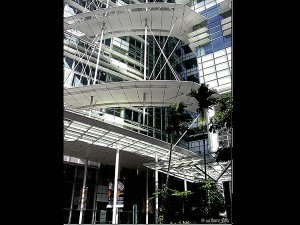
THE NATIONAL Library Building of Singapore, features sunshading devices that are said to be the widest in the world, reaching up to 1.80 meters in width. They are made of a light metallic material similar to the wings of aircraft.www.flickr.com
Public libraries have come a long way since the early days when it was simply a place for borrowing books closely monitored by a librarian whose only task it seemed was to point to a sign that said “Please maintain silence.”
Today’s modern public libraries continue to lend books but they also lend DVDs, compact discs and other materials such as magazines, newspapers and journals, all free of charge to their members.
Public libraries provide the opportunity for free access to books and educational materials, giving the community education and employment opportunities.
Green library
Many developed countries realize the importance of public libraries and the role they play in empowering the community of readers to be contributors to society.
One such country is Singapore with its iconic green structure, the National Library Building or NLB, a 16-story state-of-the-art library with a 3-level basement. The building is basically made of two blocks that house the library collections. It has space for public activities and a 615-seat theater.
The lot size is 11,304 square meters and the gross floor area is 58,783 sq m.
Green features
Upon arrival at the drop-off point in the lobby, one is greeted by a huge events plaza located between the two blocks. The entire plaza allows natural ventilation and the wind tunnel effect displaces heat to keep the plaza cool at all times.
• Sunshades. Singapore is a hot humid country like the Philippines. To cut down on solar penetration, the building is oriented away from the east-west solar exposure. In addition to this measure, the building features sunshading devices on the west side to reduce solar heat gain and glare.
These sunshading devices are said to be the widest in the world, reaching up to 1.80 meters in width. They are made of a light metallic material similar to the wings of aircraft.
The extensive use of daylight in most buildings can cause glare and discomfort to occupants. In the National Library Building, glare is controlled at the building façades with the use of blinds that adjust automatically through daylight sensors depending on the light intensity.
Motion sensors and energy efficient lighting are used throughout the building.
• Sky courts. About 10 percent of the total gross floor area is allocated for green spaces called “sky courts.” Fourteen of these green spaces are located throughout the building. This strategy helps reduce the surface temperature of the roofs and heat transfer into the building interior. The indoor temperature of the building is also improved.
The building façade has double-glazed, high-quality low-emissivity glass to reduce heat transfer.
The air distribution to the library interiors, offices and commercial spaces uses variable air volume (VAV) boxes that allow for better zone temperature control.
Carbon dioxide sensors are installed to ensure that the percentage of fresh air in the supply air is maintained at acceptable levels in all areas.
The libraries, exhibition and office spaces are largely naturally lit. A sophisticated Integrated Lighting Control System allows for strategic programming of the internal and external lights. Localized intelligent switching provides after-hours lighting only for occupied areas.
When the building was designed, the original energy target was 178 kWh/sq m/year. This was achieved within one year. Eventually, the energy-efficiency index (EEI) was brought down to 102.59 kWh/sq m/year. This is an outstanding performance considering that the Asean standard for libraries is 200 kWh/sq m/year.
Multiple awards
The National Library Building, designed by T.R. Hamzah & Yeang Sdn Bhd, is the only building recertified under existing building category Green Mark Platinum in 2009. It also won the Asean Energy Efficiency Award in 2007, the Singapore Silver Award in 2007 and the Green Mark Platinum by Singapore’s BCA in 2005.
Given the country’s favorable investment climate today, the country should take advantage and ramp up its educational platforms. A key initiative can be the development of green public libraries nationwide. This will not only provide a more conducive learning environment for our students but it can also encourage a culture of functional literacy among the Filipinos.
For comments or inquiries, e-mail amadodejesus@gmail.com.

